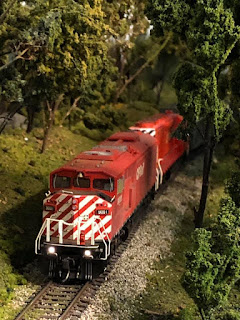If an obituary was written for a model railroad, like it is for a person,
what might it look like? Maybe like this.
CP Rail Manitoba & Minnesota Subdivision,
1994-2015
After
a long and healthy life, the CP Rail Manitoba & Minnesota Subdivision passed
away on July 19, 2019. It was 25 years-old.
Born
in 1994, the double-deck layout filled a 17 by 21-foot room in a Winnipeg,
Manitoba basement.
Basically complete by 2010, it was then significantly altered when the central peninsula—which featured
three-levels of tracks—was dismantled and reduced to a single level.
It
remained in that state until this year, when plans to move in a year or two resulted
in it being taken apart.
During
its lifetime, the M & M Sub. was honoured by being featured in Canadian Railway Modeller (several times),
Railroad Model Craftsman (twice) and
once in Model Railroader (about its
unique use of tree bark for rocks).
Information
and photos about it was also included in two Kalmbach how-to books by Tony Koester:
Model Railroading from Prototype to
Layout and Designing and Building
Multi-Deck Layouts.
In
addition to being part of many open houses sponsored by the Winnipeg Model
Railroad Club (WMRC), the layout was also on the tour schedule for the 2000 NMRA
Thousand Lakes Region Millennium Express, the 2005 Golden Rails national convention
(marking the fiftieth anniversary of the WMRC), and the 2010 NMRA
Thousand Lakes Region Steam on the Prairies convention.
It
was also featured on a blog of the same name, and is featured on a YouTube channel
with dozens of videos about the layout.
The
layout was not without its eccentricities. At a time when most everyone else is
using DCC, it remained committed—some might say stuck in the past—to DC (Dinosaur
Control).
It
also wasn’t embarrassed to use Athearn “blue box” locomotives, even if it was
more likely in recent times to find units from Kato, Rapido, Atlas and more
modern Athearn pulling trains.
It
was similar for rolling stock. Although higher quality items from Atlas,
InterMountain, Accurail and others were found in consists, so too were offerings
from Athearn “Blue Box,” Roundhouse/MDC, Lionel, Tyco and Bachmann—with new
wheels (if required) and weathering.
One thing the M & M Sub. really enjoyed was having people over, especially children. Nothing beat seeing a kid’s eyes light up when he or she was handed a controller
and told to run the train.
Over
its lifetime, the layout provided much enjoyment and satisfaction for its owner,
and hopefully for many of his friends. It will be missed.
Predeceased
by the CP Rail Grimm Valley Sub. (1988-1994), the M & M Sub. is survived by a few hundred of pieces of rolling stock and locomotives, several hundred feet of
track, a couple dozen structure, and over 700 trees—and lots
of memories.
A private service to commemorate its passing was held July 19,
2019.
Tributes
in its memory can be made by running a train, patronizing a local hobby shop, reading a model railroad magazine or inviting a child over to your layout to run some trains.
That, plus raising
a glass of your favorite cold beverage.





















